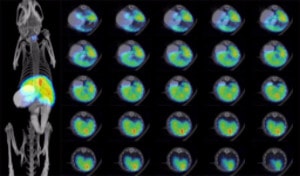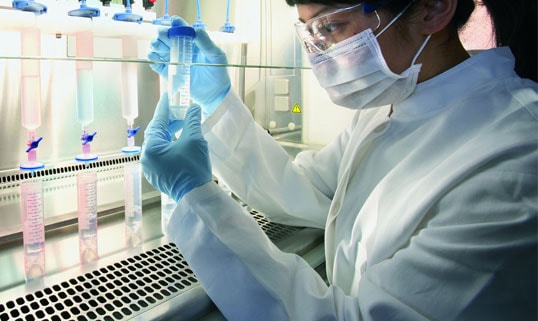B16F10-mNIS-Neo/iRFP-Puro
- Frozen / Standard (CL109-STAN) $ 2,100
Species: Mouse
Cell type: Melanoma
Transgenes: Murine sodium iodide symporter (mNIS) with neomycin resistance (Neo) for selection with G418 and near-infrared fluorescent protein (iRFP; ex/em = 690/713 nm) with puromycin resistance (Puro) for selection with puromycin
Media: DMEM, 10% FBS, 1% Pen/Strep, 0.8mg/mL G418, 1 μg/mL puromycin
Description: B16F10-mNIS-Neo/iRFP-Puro is a polyclonal population of the murine melanoma cell line B16F10 (ATCC® CRL-6475™) transduced with 1) LV-mNIS-P2A-Neo (LV025) encoding the murine sodium iodide symporter (mNIS) cDNA under the spleen focus-forming virus (SFFV) promoter linked to the neomycin resistance gene (Neo) via a P2A cleavage peptide and 2) LV-iRFP-P2A-Puro (LV032) encoding near-infrared fluorescent protein (iRFP) cDNA under the SFFV promoter and the puromycin resistance gene (Puro) via a P2A cleavage peptide.
The lentiviral vector used is a self-inactivating (SIN) vector in which the viral enhancer and promoter has been deleted. Transcription inactivation of the LTR in the SIN provirus increases biosafety by preventing mobilization by replication competent viruses and enables regulated expression of the genes from the internal promoters without cis-acting effects of the LTR (Miyoshi et al., J Virol. 1998).
Mycoplasma Testing: The B16F10-mNIS-Neo/iRFP-Puro cell line has been tested for mycoplasma contamination and is certified mycoplasma free.
Cell Line Authentication: Authentication of the parental B16F10 cell line was performed by short tandem repeat (STR) profiling with 27 STR loci. STR profiling of B16F10 cells are verified and there is no interspecies cross contamination detected.
Recommended uses:
In vitro: This is a high mNIS/iRFP expressing cell line suitable for use as a positive control cell line in iodine uptake assays and fluorescence assays to verify NIS or iRFP expression respectively in your lentiviral transduced cells.
In vivo: B16F10 cells can form tumors post implantation into mice. The in vivo growth of these tumors can be monitored using noninvasive, high-resolution 3D PET/SPECT imaging for mNIS expression or optical imaging for iRFP fluorescence.
Note: In-life imaging for iRFP fluorescence may be suboptimal due to background autofluorescence. Tissues may be harvested post mortem for analysis by conventional microscopy. Please ensure your optical imaging systems have the correct excitation and emission filters for detection of iRFP.
Morphology Cell photos: Low- and high-density cell morphology (200x)

Transgene Validation:
NIS Function Assay (Iodine Uptake): Cells were incubated with 125I for 1h in the presence or absence of KClO4, an inhibitor of iodine uptake. Radioiodine concentrated within the cells was measured with a gamma counter.

Flow Cytometry for iRFP: B16F10-mNIS-Neo/iRFP-Puro (red) or control (B16F10; grey) cells were fixed with paraformaldehyde and analyzed by flow cytometry (20,000 events).


